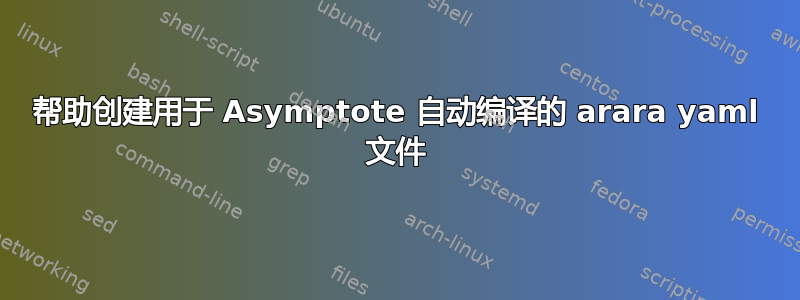
我最近发现了用于创建 3D 图形的 asymptote 包,我已经在我的计算机上安装了可执行版本并配置了 TexStudio 来运行它,只是使用工具>订单> Asymptote 手动完成,因为几个文件的编译设置不一样我使用 Arara 工具,我试图在规则文件夹中编写一个新的 yaml 文件,虽然我发现编译器告诉我它已被执行,但它失败了,我需要一个如何正确编写 yaml 代码的指导......
这是我的尝试..
!config
# Asymptote rule for arara
# author: None
# last edited by: None
# requires arara 3.0+
identifier: asymptote
name: Asymptote
command: <arara> asy @{options} "@{getBasename(file)}.asy"
arguments:
- identifier: style
flag: <arara> @{parameters.style}
default: asy
- identifier: options
flag: <arara> @{parameters.options}
我正在使用此示例代码来实现它:
% arara: pdflatex: {synctex: yes, action: nonstopmode}
% arara: asymptote
% arara: pdflatex: {synctex: yes, action: nonstopmode}
\documentclass[12pt]{article}
\usepackage[inline]{asymptote}
\begin{document}
\begin{center}
\begin{asy}[width=0.5\textwidth]
settings.outformat = "png";
settings.render = 16;
settings.prc = false;
real unit = 2cm;
unitsize(unit);
import graph3;
void drawsafe(path3 longpath, pen p, int maxlength = 400) {
int length = length(longpath);
if (length <= maxlength) draw(longpath, p);
else {
int divider = floor(length/2);
drawsafe(subpath(longpath, 0, divider), p=p, maxlength=maxlength);
drawsafe(subpath(longpath, divider, length), p=p, maxlength=maxlength);
}
}
struct helix {
path3 center;
path3 helix;
int numloops;
int pointsperloop = 12;
/* t should range from 0 to 1*/
triple centerpoint(real t) {
return point(center, t*length(center));
}
triple helixpoint(real t) {
return point(helix, t*length(helix));
}
triple helixdirection(real t) {
return dir(helix, t*length(helix));
}
/* the vector from the center point to the point on the helix */
triple displacement(real t) {
return helixpoint(t) - centerpoint(t);
}
bool iscyclic() {
return cyclic(helix);
}
}
path3 operator cast(helix h) {
return h.helix;
}
helix helixcircle(triple c = O, real r = 1, triple normal = Z) {
helix toreturn;
toreturn.center = c;
toreturn.helix = Circle(c=O, r=r, normal=normal, n=toreturn.pointsperloop);
toreturn.numloops = 1;
return toreturn;
}
helix helixAbout(helix center, int numloops, real radius) {
helix toreturn;
toreturn.numloops = numloops;
from toreturn unravel pointsperloop;
toreturn.center = center.helix;
int n = numloops * pointsperloop;
triple[] newhelix;
for (int i = 0; i <= n; ++i) {
real theta = (i % pointsperloop) * 2pi / pointsperloop;
real t = i / n;
triple ihat = unit(center.displacement(t));
triple khat = center.helixdirection(t);
triple jhat = cross(khat, ihat);
triple newpoint = center.helixpoint(t) + radius*(cos(theta)*ihat + sin(theta)*jhat);
newhelix.push(newpoint);
}
toreturn.helix = graph(newhelix, operator ..);
return toreturn;
}
int loopfactor = 20;
real radiusfactor = 1/8;
helix wrap(helix input, int order, int initialloops = 10, real initialradius = 0.6, int loopfactor=loopfactor) {
helix toreturn = input;
int loops = initialloops;
real radius = initialradius;
for (int i = 1; i <= order; ++i) {
toreturn = helixAbout(toreturn, loops, radius);
loops *= loopfactor;
radius *= radiusfactor;
}
return toreturn;
}
currentprojection = perspective(12,0,6);
helix circle = helixcircle(r=2, c=O, normal=Z);
/* The variable part of the code starts here. */
int order = 1; // This line varies.
real helixradius = 0.5;
real safefactor = 1;
for (int i = 1; i < order; ++i)
safefactor -= radiusfactor^i;
real saferadius = helixradius * safefactor;
helix todraw = wrap(circle, order=order, initialradius = helixradius); // This line varies (optional loopfactor parameter).
surface torus = surface(Circle(c=2X, r=0.99*saferadius, normal=-Y, n=32), c=O, axis=Z, n=32);
material toruspen = material(diffusepen=gray, ambientpen=white);
draw(torus, toruspen);
drawsafe(todraw, p=0.5purple+linewidth(1pt)); // This line varies (linewidth only).
\end{asy}
\end{center}
\end{document}
当编译过程启动但返回操作失败时......
Running PDFLaTeX...
This is pdfTeX, Version 3.14159265-2.6-1.40.19 (MiKTeX 2.9.6670 64-bit)
entering extended mode
Status: SUCCESS
Running Asymptote...
FAILURE
答案1
临时答复(将被取代阿拉拉4.0): 代替
command: <arara> asy @{options} "@{getBasename(file)}.asy"
经过
command: <arara> asy @{options} "@{getBasename(file)}-*.asy"
评论:我个人喜欢使用该asypictureB包,因为它允许通过简单的调用触发所有渐近线编译pdflatex -shell-escape。此外,它还允许您通过将反斜杠替换为来“走私”(扩展)渐近线图中的 LaTeX 宏\。@应用于您的示例,TeX 文件将是:
\documentclass[12pt]{article}
\usepackage{asypictureB}
\begin{document}
\begin{center}
\begin{asypicture}{name=AsyPlot}
settings.outformat = "png";
settings.render = 16;
settings.prc = false;
real unit = 2cm;
unitsize(unit);
import graph3;
void drawsafe(path3 longpath, pen p, int maxlength = 400) {
int length = length(longpath);
if (length <= maxlength) draw(longpath, p);
else {
int divider = floor(length/2);
drawsafe(subpath(longpath, 0, divider), p=p, maxlength=maxlength);
drawsafe(subpath(longpath, divider, length), p=p, maxlength=maxlength);
}
}
struct helix {
path3 center;
path3 helix;
int numloops;
int pointsperloop = 12;
/* t should range from 0 to 1*/
triple centerpoint(real t) {
return point(center, t*length(center));
}
triple helixpoint(real t) {
return point(helix, t*length(helix));
}
triple helixdirection(real t) {
return dir(helix, t*length(helix));
}
/* the vector from the center point to the point on the helix */
triple displacement(real t) {
return helixpoint(t) - centerpoint(t);
}
bool iscyclic() {
return cyclic(helix);
}
}
path3 operator cast(helix h) {
return h.helix;
}
helix helixcircle(triple c = O, real r = 1, triple normal = Z) {
helix toreturn;
toreturn.center = c;
toreturn.helix = Circle(c=O, r=r, normal=normal, n=toreturn.pointsperloop);
toreturn.numloops = 1;
return toreturn;
}
helix helixAbout(helix center, int numloops, real radius) {
helix toreturn;
toreturn.numloops = numloops;
from toreturn unravel pointsperloop;
toreturn.center = center.helix;
int n = numloops * pointsperloop;
triple[] newhelix;
for (int i = 0; i <= n; ++i) {
real theta = (i % pointsperloop) * 2pi / pointsperloop;
real t = i / n;
triple ihat = unit(center.displacement(t));
triple khat = center.helixdirection(t);
triple jhat = cross(khat, ihat);
triple newpoint = center.helixpoint(t) + radius*(cos(theta)*ihat + sin(theta)*jhat);
newhelix.push(newpoint);
}
toreturn.helix = graph(newhelix, operator ..);
return toreturn;
}
int loopfactor = 20;
real radiusfactor = 1/8;
helix wrap(helix input, int order, int initialloops = 10, real initialradius = 0.6, int loopfactor=loopfactor) {
helix toreturn = input;
int loops = initialloops;
real radius = initialradius;
for (int i = 1; i <= order; ++i) {
toreturn = helixAbout(toreturn, loops, radius);
loops *= loopfactor;
radius *= radiusfactor;
}
return toreturn;
}
currentprojection = perspective(12,0,6);
helix circle = helixcircle(r=2, c=O, normal=Z);
/* The variable part of the code starts here. */
int order = 1; // This line varies.
real helixradius = 0.5;
real safefactor = 1;
for (int i = 1; i < order; ++i)
safefactor -= radiusfactor^i;
real saferadius = helixradius * safefactor;
helix todraw = wrap(circle, order=order, initialradius = helixradius); // This line varies (optional loopfactor parameter).
surface torus = surface(Circle(c=2X, r=0.99*saferadius, normal=-Y, n=32), c=O, axis=Z, n=32);
material toruspen = material(diffusepen=gray, ambientpen=white);
draw(torus, toruspen);
drawsafe(todraw, p=0.5purple+linewidth(1pt)); // This line varies (linewidth only).
\end{asypicture}
\end{center}
\end{document}
使用以下方式编译时生成pdflatex -shell-escape
评论:我没有创建圆环,我所做的只是使用asypictureB。



